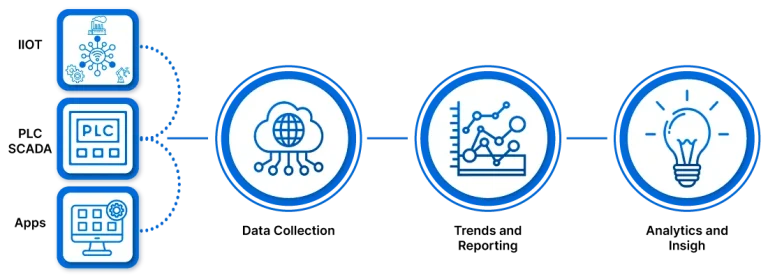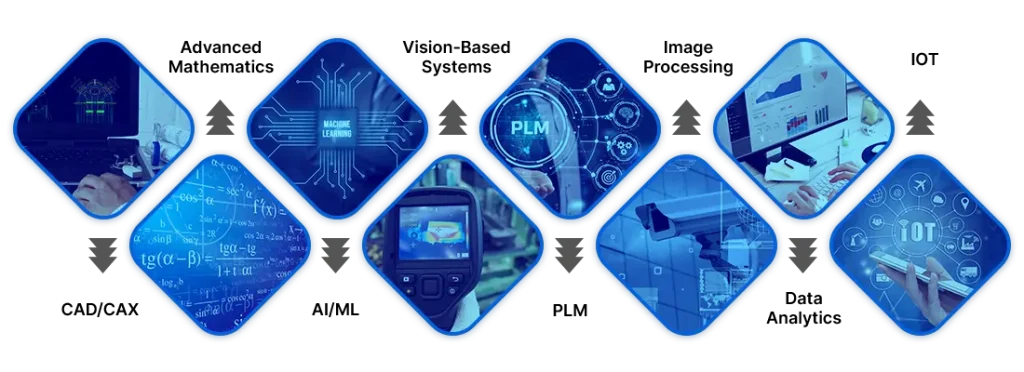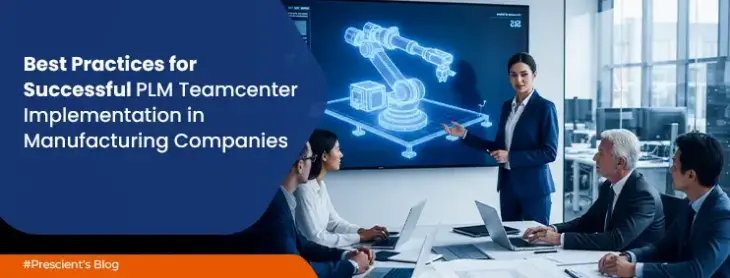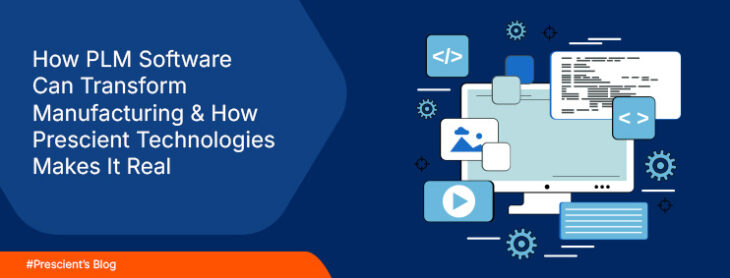Customer Login
IIoT Solutions
Unlock the Power of Industrial Internet of Things (IIoT) with Prescient Technologies
IIoT Solutions
Unlock the Power of Industrial Internet of Things (IIoT) with Prescient Technologies
Do you wish to revolutionize your industrial operations and gain a competitive advantage in today’s
fast-paced market? Prescient Technologies is your trusted partner for providing cutting-edge IIoT
solutions tailored to your unique business requirements. Using our comprehensive suite of services,
including Management Dashboard, Material Traceability, OEE Monitoring, Energy Management, and
Asset Management, we help you take advantage of the full potential of IIoT and optimize your
operations.

Services
Key Features
Streamline Operations with Our Management Dashboard
Real-time data visualization and analytics Customizable dashboards for monitoring KPIs Alerting and notification system for proactive decision-making
Material Traceability for transparency and efficiency
End-to-end visibility and tracking of materials Prevention of counterfeit or substandard materials Compliance with regulatory requirements and quality control standards Data-driven insights for optimizing material usage and reducing waste
OEE Monitoring to maximize equipment performance
Real-time monitoring and analysis of equipment performance Calculation and visualization of OEE metrics (availability, performance, quality) Identification of bottlenecks and performance optimization opportunitie Predictive maintenance capabilities to minimize downtime and improve productivity
Energy Management for optimized energy consumption
Monitoring and optimization of energy consumption Identification of energy inefficiencies and savings opportunitie Integration with energy monitoring devices and systems Reporting and analysis of energy usage patterns and trends
Asset Management for effective asset utilization
Remote monitoring and management of industrial assets Condition monitoring and predictive maintenance Asset tracking and inventory management Real-time alerts and notifications for performance deviations
Experience the Power of IIoT
Streamline Operations with Our Management Dashboard
- Real-time data visualization and analytics
- Customizable dashboards for monitoring KPIs
- Integration with industrial systems and sensors
- Alerting and notification system for proactive decision-making
Material Traceability for transparency and efficiency
- End-to-end visibility and tracking of materials
- Prevention of counterfeit or substandard materials
- Compliance with regulatory requirements and quality control standards
- Data-driven insights for optimizing material usage and reducing waste
OEE Monitoring to maximize equipment performance
- Real-time monitoring and analysis of equipment performance
- Calculation and visualization of OEE metrics (availability, performance, quality)
- Identification of bottlenecks and performance optimization opportunities
- Predictive maintenance capabilities to minimize downtime and improve productivity
Energy Management for optimized energy consumption
- Monitoring and optimization of energy consumption
- Identification of energy inefficiencies and savings opportunities
- Integration with energy monitoring devices and systems
- Reporting and analysis of energy usage patterns and trends
Asset Management for effective asset utilization
- Remote monitoring and management of industrial assets
- Condition monitoring and predictive maintenance
- Asset tracking and inventory management
- Real-time alerts and notifications for performance deviations
Why Choose
Prescient Technologies?
-
Expertise in Engineering Process Automation
-
Successful Implementations
-
Seamless Integration and Support
-
Measurable Results

875
Completed Projects
Why Choose Prescient Technologies?
Industry expertise and experience in IIoT implementations
With years of experience, our team possesses deep industry knowledge across various sectors.
Customization and scalability of solutions
Prescient Technologies is at the forefront of technology adoption. We leverage advanced tools such as machine learning and predictive analytics to deliver accurate and actionable insights.
Proactive customer support and maintenance services
At Prescient Technologies, we believe in building long-term partnerships. Our team of dedicated experts is committed to your success at every step. From the initial consultation to ongoing support,
Integration capabilities with existing systems and infrastructure
We recognize that every business is unique. Our solutions are tailored to your specific needs, challenges, and goals.
Robust security measures and compliance
Our success stories speak for themselves. Through our OEE service, we have helped numerous clients achieve significant improvements in productivity, efficiency, and quality.
Our Expertise

Featured Posts
- October 21 2025
- Prescient Technologies
Best Practices for Successful PLM Teamcenter Implementation in Manufacturing Companies
In today’s competitive U.S. manufacturing landscape, managing product data and engineering processes efficiently is critical. Many companies recognize the need for Product Lifecycle Management (PLM) systems. But choosing PLM Teamcenter Implementation Services is just the start. The real challenge lies in executing it effectively. Here’s what you need to know to get your Teamcenter implementation right and avoid costly mistakes. Why Teamcenter Implementation Matters Teamcenter by Siemens is one of the most widely used PLM platforms across American manufacturing companies. It streamlines collaboration, centralizes data, and supports the entire product lifecycle from concept to disposal. When implemented properly, Teamcenter can: But not all implementations deliver these results. Success depends on careful planning, clear communication, and expert execution. What Challenges Are U.S. Manufacturers Facing? Most U.S. manufacturers deal with data silos, outdated systems, and process inconsistencies. Without a strong PLM foundation, these issues can impact product quality, team productivity, and customer satisfaction. Ask yourself: Recognizing these issues helps you align your implementation goals with real business value. 7 Best Practices for Successful PLM Teamcenter Implementation 1. Define Business Goals Early Start with a clear purpose. What specific results do you expect from the system? These might include reducing engineering change time, automating approval workflows, or improving supply chain visibility. Clear goals help your PLM Teamcenter Implementation Services partner configure the solution to meet your needs. 2. Involve Stakeholders From Day One Bring in voices from every department engineering, quality, purchasing, IT, and operations. This creates ownership, ensures system usability, and reduces resistance to change. Stakeholders can also identify custom features they need from Teamcenter customization services. 3. Keep Initial Deployment Focused Avoid the temptation to roll out everything at once. Begin with core features like: This reduces complexity and gives users confidence with the new system before expanding. 4. Choose the Best Partner, Not Just the Cheapest Implementation is not just a technical job it’s a business transformation. Work with a provider who understands both Teamcenter and U.S. manufacturing challenges. When you choose the best partner, look for: 5. Clean and Prepare Your Data Poor data can break even the best PLM system. Legacy data must be cleaned, structured, and validated before migration. Involve experienced data engineers to: Start this process early, so your implementation stays on track. 6. Train Users and Manage Change Actively Many implementations fail due to poor user adoption. Avoid this by providing: Explain how the system helps users in their day-to-day work. When people understand the “why,” adoption improves. 7. Measure, Learn, and Iterate Track KPIs like cycle time reduction, fewer ECO delays, or improved collaboration. Use real data to identify what’s working and what needs adjustment. PLM isn’t a one-time project. It’s a continuous process that grows with your business. U.S. Trends: Why This Matters Now According to TechCrunch, the U.S. is seeing rapid PLM adoption in the automotive, aerospace, and industrial equipment sectors (2024). Companies are prioritizing modular rollouts and cloud-native solutions to reduce time and cost. Lucent Innovation also reports that PLM integrations with ERP and MES systems are becoming a standard practice among U.S. manufacturers looking for end-to-end visibility. Key Takeaways Let’s Make Your PLM Journey a Success If you’re looking to reduce product delays, increase engineering efficiency, or improve data visibility, Prescient Technologies can help. We offer tailored PLM Teamcenter Implementation Services for U.S.-based manufacturers, with industry-proven expertise in configuration, customization, and user onboarding. 👉 Talk to our experts to choose the best path for your PLM success. Contact Us Prescient Technologies has supported global manufacturers since 2000. Our offerings include Teamcenter customization services, digital factory solutions like factoryCONNECT, machineCONNECT, and powerCONNECT, and legacy modernization. Let us help you simplify your product lifecycle and focus on innovation.
Read More- October 15 2025
- Prescient Technologies
Key Features to Look for When Choosing PLM Connectors for Your Business in USA
Why PLM Connectors Matter More Than Ever Have you ever struggled with scattered product data, duplicate files, or endless switching between design and enterprise systems? You’re not alone. U.S. manufacturers are increasingly looking for smarter ways to connect siloed systems and PLM connectors are at the heart of that shift. According to the National Association of Manufacturers, 94.6% of U.S. manufacturing leaders view digital transformation as critical for competitiveness in 2025. That’s where PLM connectors can change the game. They help your CAD, ERP, and MES systems speak the same language removing delays, reducing rework, and helping teams collaborate better. If you’re looking to digitally upgrade your manufacturing operations in the USA, finding the right connector is essential. What PLM Connectors Actually Do PLM connectors allow seamless data exchange between disconnected systems. This reduces manual input, avoids errors, and improves productivity. Whether you’re handling complex assemblies or working on version control, these connectors help maintain a single source of truth for your teams. In the U.S., where sectors like aerospace, defense, and medical devices demand strict traceability and compliance, reliable PLM integration is not just helpful it’s essential. A TechCrunch report from late 2023 revealed that businesses adopting integrated PLM platforms saw a 35% decrease in product launch delays and a 28% cut in engineering overhead. Core Features to Look for in PLM Connectors When evaluating PLM integration connectors, don’t just settle for compatibility. Focus on these core features: 1. Bidirectional Data Sync Essential for U.S. manufacturers managing data-intensive environments. The connector should allow real-time two-way sync between systems like PTC Windchill and Oracle ERP. 2. CAD Compatibility Whether you’re using AutoCAD, SOLIDWORKS, or Creo your connector must be CAD-aware. This is especially critical in sectors like aerospace and automotive, where design accuracy matters. 3. Real-Time Collaboration Support Teams across cities, states, or suppliers need access to up-to-date design data. Real-time syncing ensures this especially when working with distributed teams in Detroit, Texas, or Silicon Valley. 4. Robust Security and Access Control U.S. businesses often deal with sensitive intellectual property. Your connector must support AES encryption, role-based access, and SOC 2-level data handling. 5. Error Handling & Data Validation The connector should alert users to sync failures or data mismatches. This is key in regulated industries like medical device manufacturing, where quality audits are routine. 6. Custom Workflow Support No two U.S. factories run the same process. Your connector must allow you to customize workflows, approval steps, and version control as per your SOPs. Choosing the Best: What USA-Based Manufacturers Should Consider In the U.S., smart manufacturing is being boosted by federal initiatives like the CHIPS and Science Act and the Advanced Manufacturing National Program Office (AMNPO). To align with this push, your PLM connector should support: ✔ Compliance with U.S. Standards Look for connectors that help you meet FDA 21 CFR Part 11, AS9100, or ITAR compliance, depending on your industry. ✔ Support for Cloud & On-Premise Systems Many U.S. mid-sized manufacturers still run legacy systems. A hybrid-compatible connector that works with both SaaS PLM and on-premise ERP is ideal. ✔ MES & ERP Integration For companies using SAP, Oracle, or factoryCONNECT, your connector should enable data flow from design to shop floor, with full traceability. ✔ Localised Vendor Support Choosing a vendor that offers U.S.-based support, regular updates, and timezone-aligned assistance ensures fewer disruptions. “Integration is no longer optional it’s foundational,” says Ron Miller, tech journalist (TechCrunch). “Companies that treat data as a connected asset build stronger, faster workflows.” Is It Time to Switch Your Connector? Ask yourself: If yes, it’s time to choose the best PLM integration connector one that’s built for how U.S. manufacturers actually operate. Why Choose Prescient Technologies’ PLM Connectors Prescient Technologies designs custom PLM connectors tailored for U.S. manufacturing challenges. Whether you’re in aerospace, medical devices, or heavy machinery, our connectors bridge the gap between design, operations, and compliance. We support: Key Takeaways 🇺🇸 Let’s Connect: U.S.-Ready PLM Integration Solutions Looking for a PLM connector built with U.S. manufacturing in mind?Prescient Technologies delivers integrations that are secure, flexible, and compliance-ready backed by teams who understand your industry and time zone. 👉 Talk to us now to explore PLM connector solutions that work across your CAD, ERP, and MES systems in the USA.
Read More- September 20 2025
- Prescient Technologies
How PLM Software Can Transform Manufacturing And How Prescient Technologies Makes It Real
In the highly competitive U.S. manufacturing sector, being first to market, maintaining product quality, and controlling costs aren’t just goals they’re survival. Legacy systems, fragmented processes, and versioned product data often stand between you and operational excellence. If you’ve felt the drag of disconnected tools or dreaded a change order breakdown, it’s time to see Product Lifecycle Management (PLM) software as more than a buzzword. Paired with modernization and customization, it becomes a powerful engine for growth. In this article, you’ll learn: Attention: The Cost of Staying Disconnected Many U.S. manufacturers operate with legacy systems or siloed tools CAD, ERP, spreadsheets, homegrown apps each managing a slice of your product data. The consequences are familiar: This disjointed state may mask itself as “just how we operate,” but its real cost is lost agility, wasted effort, and risk. With global competition, supply chain volatility, and accelerating customer demands, you can’t afford delays or discrepancies. That’s where PLM opens a new horizon especially when done right for U.S. manufacturing contexts. Interest: What PLM Actually Does for You Understanding PLM Product Lifecycle Management (PLM) software weaves together people, processes, and data across the entire life of a product from concept through engineering, manufacturing, service, and retirement. It becomes a single source of truth for product data across your enterprise. Wikipedia+2Fortune Business Insights+2 In the U.S., many manufacturers are turning to cloud-ready PLM stacks (often hosted on AWS or Azure), benefiting from scalability, performance improvements, and integrations with IoT, analytics, and digital twin systems. Amazon Web Services, Inc. Key Benefits That US Manufacturers Realize Benefit What You Gain Supporting Insight / Stat Faster time-to-market Product changes, approvals, BOM updates flow faster PLM solutions on AWS help reduce development cost and eliminate data silos. Amazon Web Services, Inc. Reduced cost and waste Less rework, fewer errors, fewer manual interventions End-to-end PLM can reduce defects by up to 50%. Frigate Improved collaboration + consistency Engineering, supply, quality, service all work from synced data PLM eliminates silos and improves decision-making. TriMech Enterprise+1 Better quality & traceability Track parts, versions, and history; manage audits PLM supports compliance, traceability, and regulatory oversight. TriMech Enterprise Scalability & innovation Use analytics, digital twins, and variants management The PLM market is expected to grow strongly; North America leads adoption. Grand View Research+1 In fact, North America accounted for ~35 % of the PLM market share in recent years. Grand View Research+1 The growth curve means more competitors, smarter startups, and rising expectations which makes modernization not optional but imperative. Desire: Bridging the Gap From Legacy to Next-Gen PLM “In theory, PLM is great but our systems are old, custom, fragile.” If that’s you, you’re not alone. Many U.S. manufacturers hesitate because replacing legacy systems is risky. The smarter path is modernization + extension. Here are three pillars you must integrate into your PLM journey: 1. Legacy Application Modernization Services Modernizing legacy systems is your foundation. Whether your prior PLM, ERP modules, supply chain tools, or custom utilities are brittle, poorly documented, or monolithic modernizing them is crucial. Refactor, decouple, migrate to modern platforms, remove technical debt, and open up APIs. A modern backbone ensures that your PLM doesn’t just overlay complexity it becomes sustainable, maintainable, and extensible. 2. Product Configurator Software Many U.S. manufacturers (especially those in discrete, industrial, medical, or automotive segments) deal with product variants, custom options, and configurable lines. A product configurator software tied into PLM allows: This means fewer errors, faster quotes, and better alignment between design and production. 3. Application Development Services Out-of-box PLM often doesn’t directly match every business rule or niche workflow. You may need: With robust Application Development Services, you tailor your PLM to your unique U.S. operations not force your operations to bend to a tool. A Suggested Roadmap for U.S. Implementation Here’s a phased approach that many U.S. manufacturers follow: If done well, some manufacturers see ROI in months by reducing rework, speeding time-to-market, and improving first-pass yields. Action: Why Prescient Technologies Should Be Your PLM Partner At Prescient Technologies, we specialize in guiding U.S. manufacturers through the full PLM transformation journey. What sets us apart: We believe in a practical, phased approach rather than an all-or-nothing rollout. Our team works hand-in-hand with your engineering, IT, and operations functions to ensure adoption, minimize risk, and deliver long-term value. Ready to explore how PLM + modernization could transform your product lifecycle? Contact Prescient Technologies today for a discovery session. We’ll assess your current state, outline your roadmap, and help you take the first step toward a modern, data-driven manufacturing future.
Read More1. What is IIoT?
The Industrial Internet of Things (IIoT) refers to the integration of industrial processes, machinery, and devices with Internet connectivity, allowing for real-time data collection, analysis, and communication. It enables industries to enhance operational efficiency, optimize processes, and make data-driven decisions.
2. How can IIoT solutions benefit my business?
IIoT solutions offer numerous benefits to businesses, including: 1) Improved operational efficiency and productivity 2) Enhanced asset utilization and maintenance 3) Real-time monitoring and analytics for informed decision-making 4) Increased visibility and transparency across the supply chain 5) Energy optimization and cost savings 6) Enhanced quality control and traceability 7) Proactive maintenance and reduced downtime
3. What IIoT solutions does Prescient Technologies provide?
1) Prescient Technologies offers a comprehensive suite of IIoT solutions, including: 2) Management dashboard for real-time data visualization and analytics 3) Material Traceability for end-to-end visibility and tracking of materials 4) OEE Monitoring for equipment performance optimization 5) Energy management for efficient energy consumption 6) Asset Management for remote monitoring and asset maintenance
4. Can I customize IIoT solutions to fit my specific business needs?
Yes, Prescient Technologies understands that businesses have unique requirements. Our IIoT solutions are customizable and scalable to adapt to your specific business needs, ensuring a tailored fit and maximum value.
5. How do I integrate IIoT solutions with my existing systems?
Prescient Technologies specializes in seamless integration with existing systems and infrastructure. Our expert team will work closely with you to ensure smooth integration, minimal disruption, and maximum compatibility.
6. Are IIoT solutions secure?
Prescient Technologies prioritizes data and system security. Our IIoT solutions implement robust security measures to protect against cyber threats and ensure compliance with industry standards and regulations.
7. How long does it take to implement IIoT solutions?
The implementation time for IIoT solutions can vary based on the complexity of your requirements. Prescient Technologies follows a streamlined implementation process and strives to minimize downtime during transition. The timeline will be discussed and planned during the initial consultation.
8. Do you provide training and support for IIoT solutions?
Yes, Prescient Technologies offers comprehensive training and onboarding to ensure that your team is equipped to utilize the IIoT solutions effectively. For more details contact us.
9. Can you provide examples of successful IIoT implementations?
Absolutely! Prescient Technologies has a track record of successful IIoT implementations across various industries. We have case studies and testimonials from satisfied clients that demonstrate the positive impact our solutions have had on their businesses.
10. How can I get started with Prescient Technologies' IIoT solutions?
To get started, simply reach out to us through contact@pre-scient.com. We will schedule a consultation to understand your specific requirements and propose the most suitable IIoT solutions for your business. Our team will guide you through the entire process, from solution design to implementation and ongoing support.
Featured Posts
Introduction Interaction with 3D Product Configurators What are 3D Product Configurators? Boosting sales and satisfaction Introduction Customers are often reluctant to buy customized products because...
By Swanand Javadekar A digital twin is a dynamic representation of an asset that allows us to understand the better working of the system and predict performance for better design directions. A...
For starters, digitization is converting of analog/physical things such as paper documents, microfilm images, photographs, sounds and more into digital (bits and bytes) version. So it is simply...
Allow us to help you!!
Prescient Technologies does not share or disclose your information to third parties. We value your privacy.





